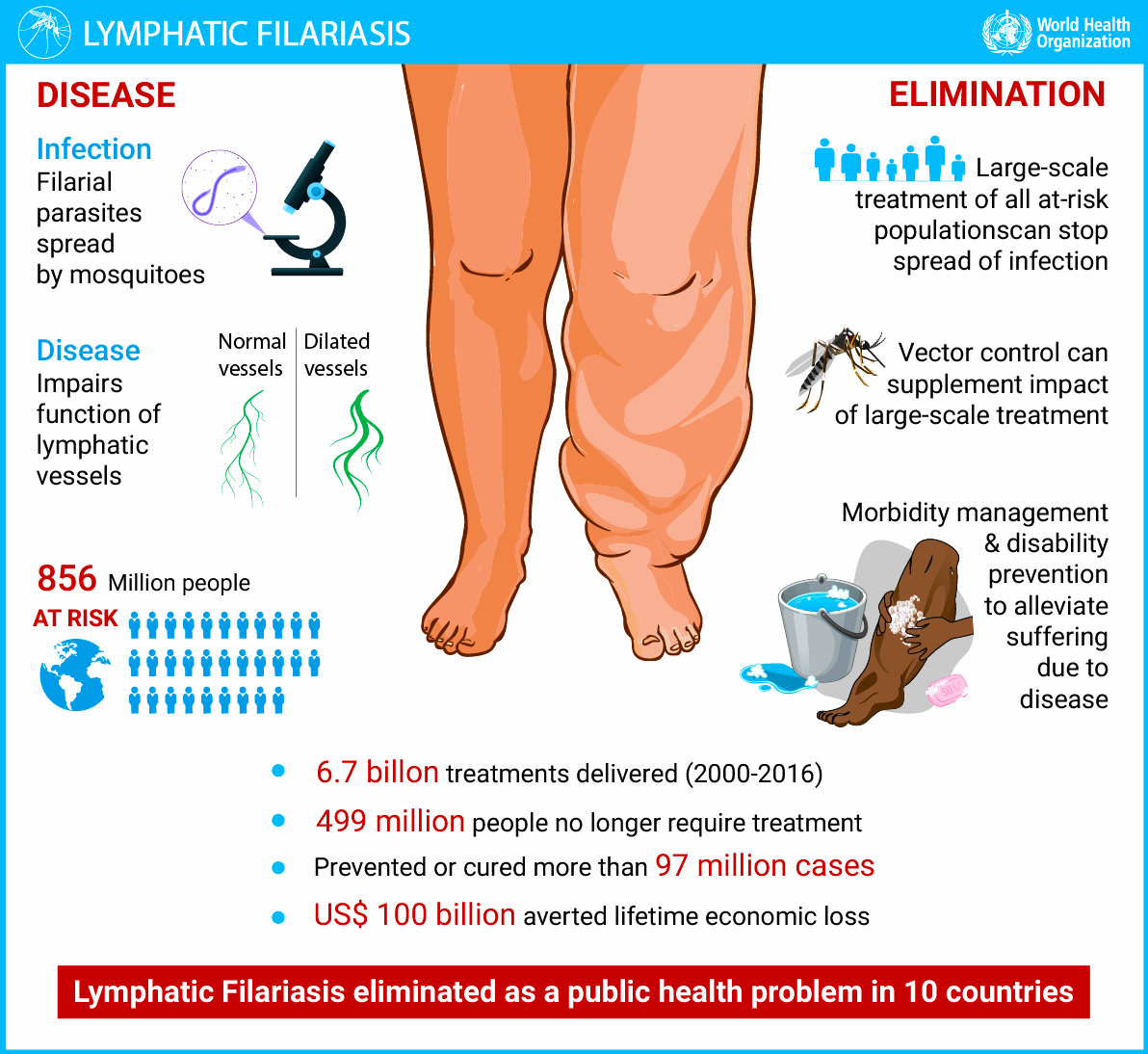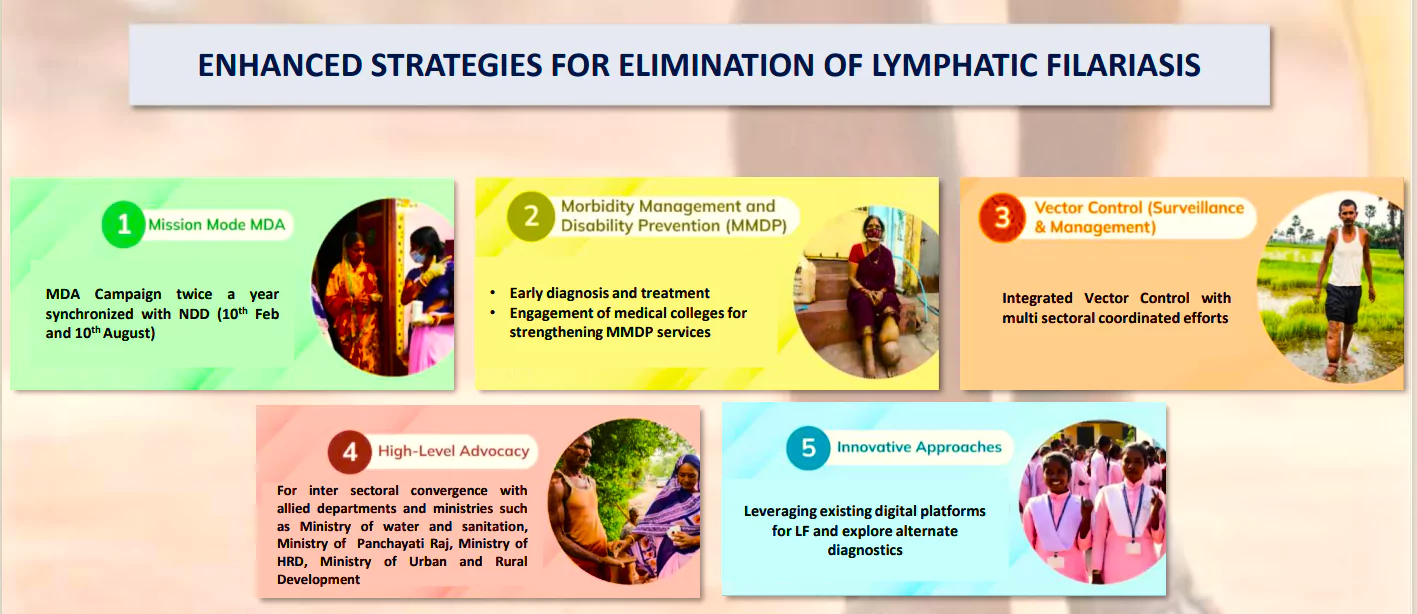Context:
Recently, the Union Minister of State for Health and Family Welfare launched the first phase of the Bi-annual Nationwide Mass Drug Administration (MDA) campaign for Lymphatic Filariasis elimination.
About Lymphatic Filariasis: It is a Neglected Tropical and a Vector-Borne Disease.
- Caused by: Lymphatic filariasis is commonly known as elephantiasis, results from parasitic (nematodes (roundworms)) worms transmitted by Culex mosquitoes, infiltrating the lymphatic system and disrupting fluid balance, causing extensive swelling—lymphedema.

-
Three Types of Thread-like Filarial Worms causes Lymphatic Filariasis
-
- Wuchereria bancrofti– responsible for 90% of the cases
- Brugia malayi– causes most of the remainder of the cases,
- Brugia timori– also causes the disease.
- Symptoms: It may be asymptomatic, acute and chronic conditions.
- Treatment: The World Health Organization recommends three drug treatments, known as IDA, a combination of ivermectin, diethylcarbamazine citrate and albendazole.
Lymphatic Filariasis Disease Incidence in India
- The 11 Endemic States: Assam, Bihar, Uttar Pradesh, Jharkhand, Odisha, Chhattisgarh, Karnataka, Kerala, Madhya Pradesh, West Bengal, and Gujarat.
- Endemic Districts: Currently, there are 345 lymphatic filariasis endemic districts in 20 states and union territories of the country.
- 75% of Mass Drug Administration (MDA) districts are from 5 states Bihar, Jharkhand, UP, Odisha and Telangana.
- Despite more than 15-20 rounds of MDA, only 138 districts have closed MDA.
India’s Initiatives for Lymphatic Filariasis Eradication:

- A Five-pronged Strategy: India has recently taken several measures to accelerate progress towards the goal of eliminating Lymphatic Filariasis. The Union Minister of Health and Family Welfare launched an advanced five-pronged strategy for the elimination of Lymphatic Filariasis by 2027.
- One of the important strategies is ‘Mission Mode India MDA Campaign’ National Deworming Day (NDD) celebrated twice a year on 10 February and 10 August.
- Nationwide Mass Drug Administration Campaigns: India is committed to eliminate Lymphatic Filariasis by 2027, three years ahead of the global target using a mission-driven strategy.
- A Collaborative Approach: India is following this collaborative approach through Jan Bhagidaari and the Whole of Government and Whole of Society approach.
Global Efforts For Lymphatic Filariasis Eradication
- Mosquito Control: By using insecticide-treated nets and indoor residual spraying, supplements preventive chemotherapy.
- Global Programme to Eliminate Lymphatic Filariasis (GPELF): GPELF is WHO’s initiative launched in 2000 to eradicate elephantiasis.
- It targets post-mass drug administration (MDA) surveillance in all endemic countries and ultimately reduces the population needing MDA to zero.
- It focuses on stopping infection spread and providing essential care to affected individuals.
- It aims to alleviate suffering among people affected by the disease through morbidity management and disability prevention (MMDP).
- WHO’s Road Map 2021−2030: It sets global targets and milestones to prevent, control, eliminate or eradicate 20 diseases including elephantiasis.
About Mass Drug Administration (MDA)
- It involves giving treatment to an entire population or every person in a geographical area, whether they are infected or not.
- Significance: MDAs are vital to help control and eliminate neglected tropical diseases (NTDs).
- They ensure that those who are infected are treated, and that those who aren’t are protected from future infection.
- Since 2016, more than a billion people a year have been treated via MDA.
|
Also Read: Mosquitofish
News Source: PIB
![]() 13 Feb 2024
13 Feb 2024


